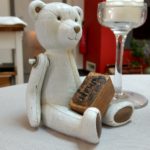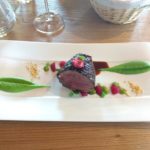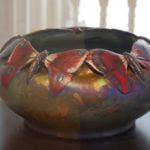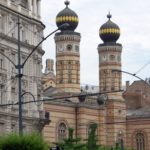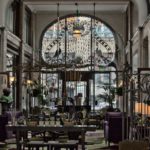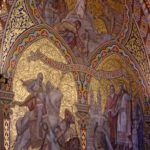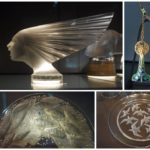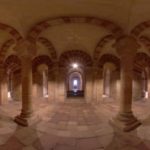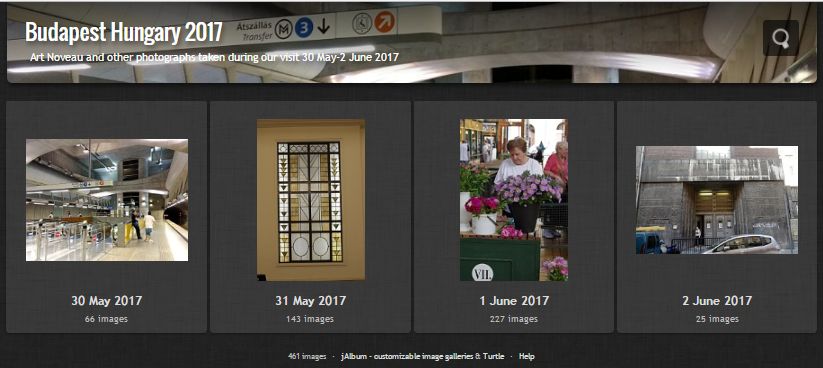To download a printable PDF version (no pictures)
click on this link E2E2017no2.pdf (seven A4 pages)
The links in the text will take you to photographs of the locations
Photographs of Budapest 30 May-2 June
Photographs of Speyer and Cathedral 21/22 June 2017
Photographs of the Lalique Museum 21 June 2017
Photographs of some of our restaurant meals
As the children of E2E throw their school things into the cupboard and celebrate being free for the whole of July and August, their grandparents are winding up their social activities and gearing up to nurture and entertain their youngsters. Elsewhere the mad rush for the motorways south to the sun is starting. In fact, the whole of France had been enjoying (or suffering) a long period of swelteringly hot weather until a few days ago, when driving rain, wind and colder weather heralded the start of the summer holidays.
The oldies of Entre-deux-Eaux had their end-of-term coach outing on Thursday. John dropped Helen off at the village shop, where the coach was waiting, and then he went off to buy 3 kg of cheap apricots to make apricot and amaretto jam in peace while the oldies were swept off to a wood on the far side of Gérardmer.
It was the kind of dark pine forest in which you could imagine Little Red Riding Hood encountering the wolf. And in true fairy tale manner, our coach came to a halt at the end of the track by a wooden workshop and a house where a toymaker and his family and his goats live and work. When we first came to live in E2E, people were amazed that we had never heard of the film “Les Grandes Gueules”. But you have at least heard of the famous actor Lino Ventura? Such ignorance was shocking. Why, the film was made back in 1965 in the forests round Gérardmer at an old saw-mill not far from the toymaker’s workshop. In the workshop we watched clips from the film along with short films of the toymaker’s life through the decades, and then he showed us his tools, machinery, wood and stencils; the stencils hung silhouetted against the big window like Christmas decorations. After we visitors had stocked up with wooden trinkets and wooden toys for the grandchildren from the tiny toyshop, the coach raced through the forest and performed a tight five-point turn to the village of Liézey and the highlight of the expedition, the Ferme-Auberge de Liézey.
Everything was as it should be at the traditional inn, down to the long tables with their red-and-cream checked place mats, the red-and-cream patterned curtains and the lace-draped low lights. Aperitifs of sangria (possibly not typically Vosgian but “fashionable” back in the fifties and sixties) or kir were served, and then little glasses of delicious beetroot cream and garlic mousseline and a sweet bread with smoked ham chunks in it. These were followed by a starter – a large plate of salade vosgienne, a green salad garnished with warm fried potatoes and smoked bacon chunks. Next came even bigger plates of tofailles, not a word found in most French dictionaries, but a traditional Vosgian dish for which everyone has their own recipe, but which contains more potatoes, more smoked pork and more onions! Then cheese was brought – three huge chunks of two different Munster and a Tomme des Vosges. Followed by enormous slices of tarte aux myrtilles, a tasty bilberry tart, which left the ladies anxiously examining their teeth in the privacy of the ladies’ loo to see how purple they looked. By the time we had drunk coffee it was nearly four o’clock, four hours after we had sat down at table, and no one was inclined to make a dash through the heavy rain back to the coach. But we had one more rendez-vous, down at the saboterie in Gérardmer, where we watched the traditional wooden clogs being made (one of the machines dated from 1913) and the oldies reminisced about going to school in wooden clogs which got further weighed down in winter by the snow that wedged under them. Helen’s neighbour on the coach bought a new pair for the garden, and others bought diminutive single clogs decorated with dried flowers as a souvenir of the old days.
For the previous month’s gathering of the E2E oldies John had confected a chocolate, hazelnut and meringue dacquoise for the spread of birthday cakes on which the candles were duly lit to the strains of joyeux anniversaire. Helen nearly missed the cake and champagne as the former mayor, M. Chaxel, was leading one of his “walks”, this time a car tour of the E2E monuments. First he drove his old car up a bumpy forest track from the church up to a farm and onto another track to the Behouille hilltop which led past a remote farmstead house; M. Chaxel spoke of the sisters who had lived there all of their lives and remembered wounded soldiers being brought into their house from the battle at the start of the first world war until they could be taken down to hospitals. In a clearing a few hundred yards up the track stand six memorials to the 520 Chasseurs and Chasseurs Alpins who died there on 3rd September 1914. When we looked at two further memorials outside the hamlet of Fouchifol, the ex-mayor told us the little known fact that one of them had originally been erected by Sergeant Pillet’s parents where he fell, a short walk above our house, but as it had got overgrown by forest it had been moved to this more prominent position by the roadside. As we stood by the stone at La Planchette commemorating two members of the second world war Maquis who were hanged by the Germans after gathering for an anticipated parachute drop, we were brought back to the present by a car that stopped. Out of it stepped an elegant lady flanked by two women in yellow T-shirts printed with President Macron’s name. President Macron had just been elected, despite the E2E election preference for Marine Le Pen (57.84% in the second round). There were mutterings of “Not more politics!” But the elegant lady was out campaigning as a candidate for the parliamentary elections which would follow. The only political comments to be heard from the oldies are moans about pension levels compared to state handouts for the undeserving who’ve never done a day’s work.
Sadly, our neighbour Danielle Laine, who many of you will remember from visits in the early days as a bustling active woman, had to miss the oldies’ end of term trip as she had had yet another fall and had broken her pelvis. “I keep falling now” she whimpered, but has insisted on leaving hospital to look after her husband Pierre; fortunately her health insurance covers some home-help, and her daughter is about 12 km away. Helen was entrusted with the task of inspecting the now inaccessible vegetable plot below her window and reporting on size and colour of tomatoes, beans, courgettes and cornichons (large gherkins for pickling).
In fact over the last three months our own vegetable plot and the grass in the field, orchard and pretentious-sounding arboretum have kept us busy between travels and sorties since April. At the moment we are enjoying broad beans, peas and dill with the first courgettes and blueberries to be picked today.
But before starting gardening at the end of winter (end of April here), we enjoyed seeing the family in Letchworth in early April. We stopped to see John’s sister Ann and Derek now happily settled in Kent and Leila was able to join us in Letchworth for a long weekend. Toby did a good BBQ in the April sunshine, Jacob and Farrah did treasure or egg hunts in our garden, the adults hunted for good bluebell woods in nearby counties (finally finding a lovely bluebell hill outside Hitchin), and we had a good day in London seeing “Rosencrantz and Guildenstern are Dead”, recent developments round Kings Cross, the Foundling Hospital in Coram fields and trying out the well-reviewed Luca restaurant in Clerkenwell (disappointing).
Soon after our return we consoled ourselves for the disappointing London restaurant with a trip into the countryside of the book village, Fontenay-la-Joute, for lunch at l’Imprimerie, the innovative restaurant with no printed menu (this whim of the chef is becoming more common). Snow had fallen in E2E the previous day, which was a surprise after sitting outside so recently for a BBQ, but as we left the hills behind we left the snow too. The chef’s partner had returned from her maternity leave and we were served by her and by their three-month old baby who was in a sling across her chest and watching everything with alert interest. We wonder what the Michelin inspectors would make of this unusual restaurant. Helen’s favourite dish was the starter of langoustine, foie gras, fennel, radish and grapefruit presented in two different ways, though an amuse bouche of asparagus in green tea and potato cream ran it a close second. There were some interesting wines too, apparently chosen from smaller producers through internet advice as there is no time to travel and sample. The label of the Flying Solo grenache syrah from Languedoc Roussillon recalled the flying postal service that Saint-Exupéry wrote about. Their use of ransoms in the soup and as a pretty garnish to a couple of other dishes, made us later go to the end of our vegetable patch and start picking and using the plant that a German friend, Margrit, had given us many years ago saying it was useful for salads; we’d never used it as it didn’t look promising for salad and it gets rather submerged later in the year by the horseradish and by nettles. So it was good to finally appreciate it; it really jazzes up a pasta!
Restaurant trips in May were varied. Helen’s birthday was celebrated in the shadow of the bottled-water factory outside the quaint Alsace village of Ribeauvillé and on the edge of the vineyards (some readers may recognise the Carola Parc from this description, where we went of the Friday of her 70th birthday celebrations). The little town with its storks’ nests was at its sunniest best as we strolled before lunch through the back streets and old gateway and past the people sipping coffee and eating chocolate cake outside the patisserie. After lunch there was the inevitable DIY emporium and a garden centre (John bought Helen some birthday geraniums, strawberries and lavender to plant out). Next day it poured with rain when we joined Helen’s Keep your Brain Active group for lunch at the Grand Spa Hotel in Gérardmer; they are a very sociable and welcoming group and the lunch was OK, in a Vosgian way too, but no post-prandial walk round the lake, which could hardly be seen through the rain. The following week, with temperatures up to thirty degrees, we drove over the hills to Steige and the Restaurant Guth’s wooden chalet on the hill above the village This time there was no goat to greet us, – had it been eaten or just found a shadier spot?
The young chef Yannick cooks from ingredients foraged in the forest behind which included nettles, ransoms, fir buds and sorrel and the beef was cooked over aromatic bark and wood. The casserole of beef with its tantalising aromas was brought to the table for inspection before reappearing barkless on a rectangular plate between bright green leaf shapes of broad bean purée, raspberries and a wild herb sauce. In a neighbouring village, there is a man who supplies interesting cheeses. We asked about a strongly-flavoured one we liked and took a while to realise that the tasty marbled “sshheedh” turned out to be, when the word Scottish was added, a cheddar. The wild saffron “spring walk” dessert was wonderful and like nothing else we’d ever tasted. On the basis of our descriptions, Leila chose to go there with us while she was over in June, and we opted to relive the same menu deliciousness, with its seasonal variations; the wild snails in a parsley, spinach and garlic sauce having been replaced by a beautifully presented foie gras from a local farm served with thyme-flavoured toast. This time we had our coffee out on the balcony in the sun and enjoyed the wonderful panoramic view. Leila loves the little shops and the cobbled streets of Kaysersberg so we went there one day with her and enjoyed a very good menu-of-the-day at the Alchemille which is another recent discovery; fortified by a good lunch, John nobly endured the tourist streets of Kaysersberg afterwards without even looking pointedly at his watch.
Have we gone on for too long about food again? The week before Leila’s visit, we’d taken a last-minute mid-week flight to Budapest (from Basel).
Despite the heat-wave there was still snow on the mountains we flew over. And despite the heat we enjoyed walking round the town looking mainly at art nouveau and art deco buildings – outside, and inside where possible. On the first afternoon we walked from our pleasant guest room to the big market by the river and the ornate Museum of Applied Arts (whose exterior for some reason reminded me of the railway station at Bombay).
The main exhibition was of collectors and their treasures, and hinted at the underfunding for state arts and museums (presumably under the communists) and the wave of collections acquired with the dispersal of the aristocratic owner/collectors, a reminder of the opulent stately homes where Patrick Leigh-Fermor stayed on his pre-war walk across Europe and their aristocratic libraries and treasures. The temporary exhibition on Marcel Breuer’s tubular steel furniture and Farkas Molnar’s modernist and art deco buildings was very interesting, along with furniture from other Hungarian designers.
The following day we made the most of the varied forms of Budapest transport (all free for the over 70s) to escape from the city heat to the hills: a tram round the ring road from our accommodation in Pest to the Buda side of the Danube, a fascinating but almost solitary journey uphill on the cog railway (why had the driver got a folded step-ladder in his cab?) past wooded villas (including several which echoed the previous day’s exhibition), then a short walk to the children’s railway, built after the war and run by Pioneers, the Youth Section of the Communist Party.
The ticket office had a young school girl earnestly explaining the tariffs but struggling with a Scottish accent in front of us, the train conductors seemed very small and inaudible, but the station master was an older po-faced boy who saluted gravely as our train drew into the station, packed with excited nursery-aged children. The children who staff it take a two-week assignment from school. Reassuringly the driver and signal people were grizzled adults. The light breeze in the open carriage was cooling as we passed signals and stopped at stations, one with a wonderful forest play area (the old Pioneer Youth Camp) and others with flourishing cafeterias; three trains passed in the opposite direction on the 12 km curving route, so it’s a popular line, and the small children all squealed as we plunged into a tunnel. What larks! We could have got off half-way, walked through the forest and taken a chair lift down, but we stayed on till the terminus and tamely caught a busy bus replacement (the tram track was being repaired). Back in Pest we sat in a cafe opposite the
Great Synagogue, an extraordinary domed and striped brick building (more reminiscent of a mosque); unfortunately the synagogue and most other Jewish buildings were closed during our stay (presumably for Shavuot). So we hopped on a passing old tram through the Jewish area to the ring road, where we ventured into some of the lavishly restored buildings like the opulent New York Café and Hotel (built in the 1890s by a New York Insurance firm) and the Art Nouveau Palace Hotel of 1910 (now a Novotel).
But sadly the splendid Paris Department Store on Andrassy had a removal van outside; the entrance was barred by two men who explained that the bookstore which had been inside for a few years was bankrupt and so empty and the famous Lotz cafe could not be visited. Instead we sneaked into the foyers of the florid Operetta, Thalia Theatre, Photographic Museum and Opera, before retreating hot and sticky to our guest room to cool down. The owner recommended a typical Hungarian restaurant by the big market where we ate that evening; the plates of crispy duck, cabbage and fatty potatoes and of steak and onion rings were piled high; the dulcimer player was bored and kept stopping mid ripple to retune, and for some obscure reason it was “not possible” to serve the shared dessert sponge and chocolate sauce without the lashings of cream, which we removed without problem. Afterwards we strolled across the Liberty (Szabadsag) Bridge with splendid views of the illuminated monuments on the hill tops and of illuminated passing river boats below. We peered into the decadent fin-de-siecle Gellert Hotel and Spa before returning on our splendidly modern line 4 of the Metro.
Next morning, having explored a smaller local indoor market, we took the same Metro 4 line back to the central market, which was less packed than before, where we bought paprika downstairs and examined the embroidered cloths and table runners upstairs. We took a tram along the Danube to the Szecheny Chain Bridge and detoured to the beautifully restored Gresham Palace (built by the British Gresham Insurance Company in 1907 as luxury flats, expropriated and divided into smaller flats by the Communists in 1948 and now the Four Seasons Hotel). We admired and John photographed the peacock wrought-iron gate, the Zsolnay tiles, the stained glass and the mosaics then sipped lattes and bottled water in the café as the waiters cleared away the late breakfast things.
Outside the traffic was at a standstill on the bridge and there were huge tourist queues for the funicular on the Buda side, so we slowly walked up the hill to the Fishermen’s Bastion where the mid-day sun beat down mercilessly on the large square.
The dark cool of the Matthias Church glittered with gold frescoes and deliciously over-the-top Neo-Gothic decoration, and in the dark cool gloom of the vast Neo-Romanesque Archives there was an exhibition, “Their Traces”, of signatures from the thousands of documents (Royal, German and Communist) which survived the 1945 Siege of Budapest and the 1956 Revolution despite bomb explosions and the destruction of stack rooms. That evening as we walked back from a restaurant we came across the ornate entrance to the 1912 Trade School on the next street from our room; John dashed out to photograph it after breakfast next morning before we had to leave for the airport. The Easyjet “departure gates” at the airport were in a stuffy corrugated iron structure on the tarmac with the sun beating down on it, and staffed by officious officials who did their best to puncture our happy impressions of Budapest.
Back in Entre-deux-Eaux the heat continued. At the village flea market up on the football pitch we bought some mint plants to replenish our submerged pots, and we drove to the Strasbourg IKEA to buy some lightweight summer duvets. We took a new route home from Strasbourg via the village of Wolxheim, to buy some pinot gris we’d enjoyed at the Epinal restaurant “In Extremis”. Visiting a wine producer is a serious affair, as you have to taste other wines too, and a young woman was summoned from one of the vineyards to discuss their various merits. It turned out that she and her sister had visited the young Epinal chef’s restaurant when he was near Lyons; she loved his food and was anxious to know what he had cooked for us to accompany their wine. So out came John’s phone and photos of our recent meal. An hour later we left with our two boxes and she threw in a complimentary bottle of their muscat which we had not tasted.
Two days later more complimentary drinks arrived, this time two bottles of still water delivered by our neighbour Claudine, who is a local councillor. She explained that for the first time ever the independent three-monthly inspections had identified that the water from one of the local sources was contaminated by E. coli and should not be used for drinking or food preparation, and produced a letter from Mayor Duhaut to that effect. Leila was impressed that we were regularly supplied with free bottles of water assuming English councils would not do so, but she has never experienced standpipes on street corners.
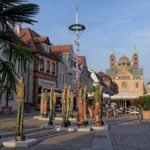 A few days after the water purity was re-tested and pronounced acceptable and Leila had flown home, John suggested driving up to see the Romanesque cathedral of Speyer which Helmut Kohl was so fond of (he took Margaret Thatcher and many other leaders there). We booked an overnight hotel, and decided to stop on the way at the Lalique museum in Wengen-sur-Moder deep in the Alsace forest bordering Germany (and quite close to some of the Maginot Line fortresses). It was a pleasant drive north from here via Baccarat into the northern Vosges.
A few days after the water purity was re-tested and pronounced acceptable and Leila had flown home, John suggested driving up to see the Romanesque cathedral of Speyer which Helmut Kohl was so fond of (he took Margaret Thatcher and many other leaders there). We booked an overnight hotel, and decided to stop on the way at the Lalique museum in Wengen-sur-Moder deep in the Alsace forest bordering Germany (and quite close to some of the Maginot Line fortresses). It was a pleasant drive north from here via Baccarat into the northern Vosges.
The museum was modern, spacious and cool, and we enjoyed the rich displays of Lalique’s jewellery, perfume bottles, car radiator mascots, drawings, chandeliers, church glass and beautiful crystal and glass tableware and vases. We also liked the town of Speyer and our comfortable hotel, but found the cathedral rather soulless, perhaps because of its famously huge size and because the old Romanesque building had been rebuilt in Baroque style after a fire in the seventeenth century and had then been stripped of all that gilding and the frescoes and returned to a plain building at the end of the last century.
The crypt had retained the feel of the Romanesque original. We saw an interesting film of the restoration work in the nearby historical museum. But all the time I could imagine Margaret Thatcher saying, “Next time you are in England, Helmut, I must take you to see Ely cathedral. Biggest isn’t always best.”
To round off the end-of-term activities, Helen returned on Friday from her last Scrabble game, a special one with a joker in every round and a seven letter word to be found on most moves. Suddenly we were free of commitments. So why not get Snowy’s MOT-equivalent done and set off to Letchworth again before the English summer holidays and Toby and family’s visit here?

